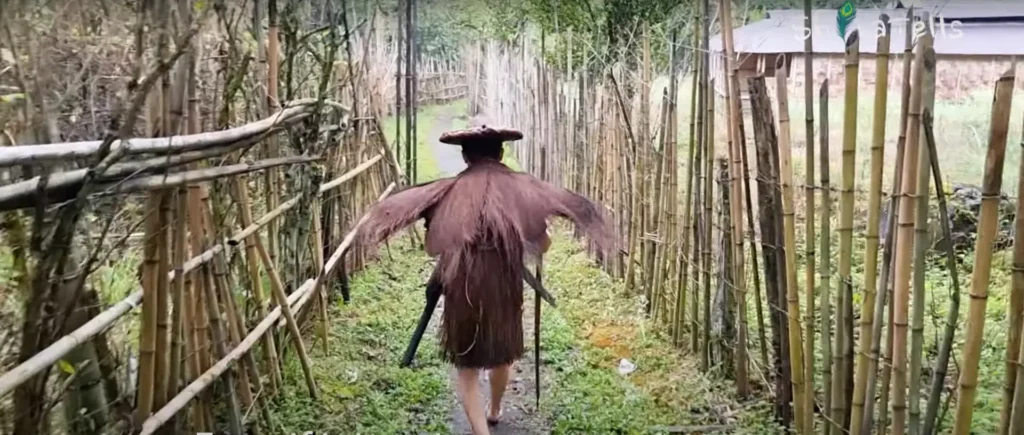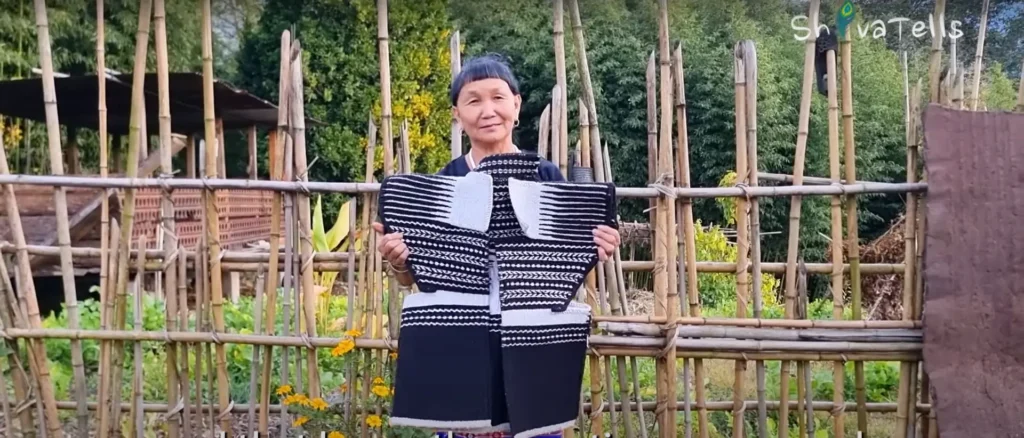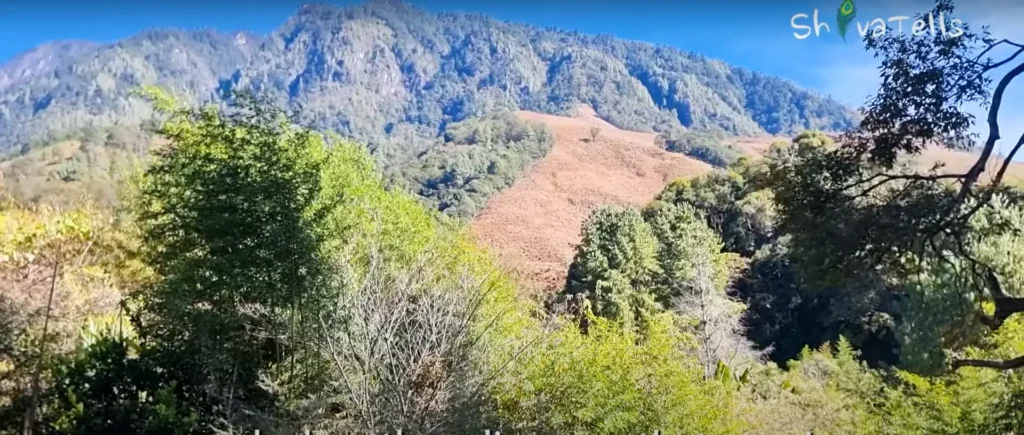I’m back with a story that’ll have your adrenaline pumping faster than a hummingbird’s heart on Red Bull! Imagine a place where the first rays of the sun kiss the earth, painting the mountains in a golden glow. This mystical land, shrouded in mist and whispered legends, is Arunachal Pradesh, the “Land of Dawn-Lit Mountains.” Here, nestled amidst emerald valleys guarded by snow-capped peaks, dwells a tribe unlike any other – the Idu Mishmi Tribe, the protectors of wildlife and keepers of ancient wisdom. They call themselves the “Tiger Tribe,” and their story is woven with the secrets of the forest, a tale of respect for nature and a deep connection to the wild.
Forget the usual tourist traps. This adventure isn’t about five-star resorts and selfie sticks. This is about immersing yourself in a culture where tigers are revered as kin and the rhythm of nature dictates the flow of life. Are you ready to unlock the secrets of the Idu Mishmi tribe? Let’s embark on a journey where every turn unveils a fascinating tradition, a breathtaking view, and a heartwarming story about living in harmony with the Earth. Buckle up, because we’re about to get wild!
The path ahead twists and turns, each bend promising a hidden treasure – a glimpse into an ancient tradition, a view that’ll leave you speechless, or a tale of humans and nature living in perfect balance. Are you ready to unravel the secrets of this wild place? Strap yourselves in, because the adventure begins now!

Table of Contents
Where are the Idu Mishmi Tribe and What’s Their Vibe?
Imagine waking up to a view of snow-capped peaks and lush valleys. That’s the daily reality for the Idu Mishmi tribe who call the Dibang and Lower Dibang Valley districts home. You’ll also find them chilling in parts of Lohit and Upper Siang.
These folks are part of the larger Idu Mishmi tribe, but they stand out for their strong connection with the environment. They’ve been living amongst these stunning mountains for generations, and their homes reflect that perfectly. Think beautiful houses built on stilts, using bamboo, wood and local leaves – a sustainable and totally cool way to live!
Here’s the sad part, though. Their language, a vital part of their heritage, is considered endangered. So, if you ever meet an Idu Mishmi, be extra nice and show some respect for their awesome culture!
From Hunters to Guardians: How the Idu Mishmis became Wildlife Rockstars

Believe it or not, hunting used to be a big part of the Idu Mishmi tribe way of life. But, unlike others who went a bit overboard, these guys realised the importance of striking a balance with nature. So, they did something pretty darn smart – they wove environmental protection right into their traditions!
Now, hunting is only allowed under special circumstances, and even then, there are strict rules called Aangii (or ena) to minimize its impact. These rules are pretty interesting, let me tell you! Imagine the hunter having to put his social life on hold, his wife too! All to ensure a successful and respectful hunt. Pretty hardcore, right?
But wait, there’s more! Certain animals are completely off-limits for hunting – the Misu. These are basically the VIPs of the animal kingdom for the Idu Mishmi tribe. They’re considered bad omens or hold cultural significance, showing just how deeply these folks respect all living things.
Tigers: Not Prey, But Family!

Here’s where things get fascinating. The Idu Mishmi Tribe have a mind-blowing belief system around tigers. They see them not as ferocious beasts, but as kin, descended from the same ancestor as humans! Hunting a tiger is like harming your own brother – a big NO NO in their world.
This belief is a major reason why tigers continue to thrive in their territory. Even if a tiger nabs one of their prized cows, they suck it up because harming the tiger is just not an option. Talk about respect!
Hold on! Didn’t you say something about them being unhappy about a sanctuary?
Ah, good question! The Idu Mishmi Tribe are actually a bit worried about a recent plan by the government to convert the Dibang Wildlife Sanctuary into a tiger reserve. They fear restricted access to the forests which are crucial for their livelihood and traditions. It’s a tricky situation, but hopefully, they can find a way to work together with the authorities for the best outcome for both humans and tigers.
Lessons from the Idu Mishmi Tribe: Living in Harmony with Nature
The Idu Mishmi Tribe are a living example of how cultural traditions and beliefs can be powerful tools for conservation. They’ve figured out a way to live alongside nature, not against it.
Here’s the challenge, folks. Can we, the modern world, learn a thing or two from them? Maybe it’s time we stop seeing nature as something to conquer and exploit, and instead, focus on living in harmony with it.
So, what do you think? Pretty cool, right? If you ever get a chance to visit Arunachal Pradesh, try to learn more about the Idu Mishmi tribe and their amazing culture. And remember, always be respectful of the environment, wherever you travel!
Don’t just take my word for it: A Day in the Life (sort of) with the Idu Mishmis!

Alright, alright, I know blogs are cool and all, but wouldn’t it be even cooler to actually experience life with the Idu Mishmi Tribe? Well, fret not, my friends! Since we can’t exactly teleport ourselves to Arunachal Pradesh (although wouldn’t that be awesome?), let’s use our imaginations and take a peek into a possible day with the tribe.
Morning Melody:
The first rays of dawn paint the sky a fiery orange as you wake up in a traditional Idu Mishmi house. The cool mountain air nips at your nose, and you hear the gentle murmur of a stream nearby. Instead of the usual alarm clock, you’re greeted by the melodic chirping of birds and the rhythmic pounding of rice being husked.
Weaving Wonders:
After a breakfast of local fruits and rice porridge, you join the women as they weave intricate patterns on their looms. The rhythmic clack of the shuttle and the vibrant threads being woven tell stories of their ancestors and the deep connection they have with the forest. Maybe you’ll even get a chance to try your hand at this age-old craft – who knows, you might surprise yourself with your hidden weaving talents!
Aangii in Action:
Later in the day, you witness the Aangii code in action. A young hunter is preparing for a rare permitted hunt, and the entire household is buzzing with nervous energy. He observes the rituals – no loud noises, no social interactions – anything to ensure a successful and respectful hunt. It’s a humbling experience to see how seriously they take this responsibility.
Nature’s Classroom:
As the afternoon sun warms your face, you head out with a group of Idu Mishmi Tribe children into the lush forest. They point out medicinal plants, teach you the names of birds by their calls, and share stories about the mischievous monkeys that swing through the trees. It’s a nature lesson unlike any you’ve ever had, filled with wonder and respect for the environment.
Starlit Stories:
As night falls, a bonfire crackles in the center of the village. You gather around with the elders, listening to them weave tales of tigers and spirits, passed down through generations. The firelight dances in their eyes as they speak of the delicate balance between humans and nature, a message that resonates deeply.
Remember, this is just a glimpse!
This little adventure is just a taste of what life could be like with the Idu Mishmis. Their culture is rich and complex, filled with traditions, folklore, and a deep respect for the natural world.
So, the next time you’re looking for a travel destination that will leave you inspired, consider Arunachal Pradesh and the Idu Mishmis. They might just teach you a thing or two about living a life in harmony with nature.
Beyond Arunachal Pradesh: The Idu Mishmis’ message for the World

We’ve travelled through misty mountains, learned about ancient traditions, and even gotten a taste of life in an Idu Mishmi tribe village. But here’s the thing, folks – the lessons from the Idu Mishmis hold value far beyond the borders of Arunachal Pradesh.
A Call for Change: Our planet is facing some serious environmental challenges. Deforestation, pollution, and climate change threaten the delicate balance of ecosystems around the world. The Idu Mishmi tribe, through their traditions and beliefs, offer a powerful message – it’s time to change our ways.
Sustainable Swaps: Can you imagine a world where communities live in harmony with nature, taking only what they need and giving back in return? The Idu Mishmi Tribe, with their sustainable practices like building houses using local materials, show us that a different way of living is possible.
Respecting All Creatures: The concept of Misu, animals considered sacred or off-limits for hunting, reminds us of the interconnectedness of all living things. We need to move away from a human-centric view of the world and start respecting all creatures, big and small.
Finding the Balance: The Idu Mishmi Tribe aren’t saying we all have to ditch technology and live in bamboo houses (although, wouldn’t that be an interesting experiment?). Their message is about finding a balance. We can still have our modern comforts, but we need to do so responsibly and sustainably.
Become a Champion for Change:
So, how can you, as a traveller or just a concerned citizen, become a champion for change? Here are a few ideas:
- Reduce, Reuse, Recycle: These golden rules are more important than ever. Be mindful of your consumption habits and try to minimize waste.
- Support Sustainable Businesses: Do your research and choose products and services from companies that are committed to environmental responsibility.
- Spread the Word: Talk to your friends and family about the importance of protecting our planet. Share what you learned about the Idu Mishmi Tribe and inspire others to make a change.
- Travel Mindfully: When you travel, choose destinations and experiences that promote responsible tourism and respect for local cultures and ecosystems.
How To Reach Dibong Valley, Arunachal Pradesh?
Dibang Valley beckons with its untouched beauty, like a secret whispered on the wind. While reaching this paradise might take a little effort, the journey itself becomes an adventure. Here’s how to unlock the magic:
- Soar Through the Skies: Mohanbari Airport in Dibrugarh, Assam is your gateway. From there, a car or taxi whisks you 148 km to Roing, the heart of Dibang Valley. Breathe in the fresh mountain air as the scenic landscape unfolds before you. (Think – a 3-4 hour road trip with breathtaking views!)
- Iron Horse Adventure: Budget travelers, rejoice! New Tinsukia Junction, 138 km from Roing, is your train station. Hop off and choose your next ride – a comfortable bus or a private taxi. The road journey (around 3 hours) promises to be a delightful prelude to Dibang Valley’s charm.
- Road Trip Diaries: Dibang Valley welcomes those who love the open road. Buses from Itanagar, Arunachal Pradesh’s capital, or major Assamese towns like Guwahati and Dibrugarh, can be your companions. Imagine the ever-changing scenery as you get closer to your destination.
Remember the Key: A special permit, the Inner Line Permit (ILP) for domestic tourists and the Restricted Area Permit (RAP) for international visitors, is your key to exploring Arunachal Pradesh. These can be obtained from designated government offices in Itanagar, Delhi, Kolkata, Guwahati, Shillong, Dibrugarh, Tezpur, North Lakhimpur, and Jorhat.
Remember, every little bit counts!
By following these tips and embracing the spirit of the Idu Mishmi tribe, we can all play a role in creating a more sustainable future for our planet. Let’s work together to ensure that future generations can continue to experience the beauty and wonder of the natural world, just like the Idu Mishmi Tribe have for centuries.
So, what are you waiting for? Join the movement! Together, we can be the guardians of our wildlife and protectors of our planet.
Other stories from Arunachal Pradesh
- WIND festival of TUTSA Tribe | Tutnu Village | Pongtu Festival
- Are you WORTHY to wear this HELMET?? | Nyishi Tibe | Arunachal Pradesh |
Also Read About Other Tribe Stories
- Whispers in the Patkai Hills: The Story of the Wancho Tribe in Arunachal Pradesh.
- Hidden Karen Tribe in Andamans : Culture, Bamboo Crafts, Archery and Folk Songs
FAQs
-
What is the Idu Mishmi Dance from Arunachal Pradesh?
The Idu Mishmi of Arunachal Pradesh have several dances. Some celebrate harvests and daily life, while others are ritual dances performed by priests during ceremonies like the Reh festival. There’s also a fertility dance performed during the Rren ceremony.
-
What is Idu Mishmi’s Origin?
Idu Mishmi origins are debated. One theory suggests migration from Tibet, aligning with their language family. Another, less common view, proposes migration from Burma.
